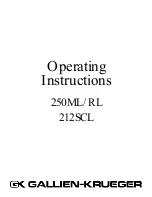
Introduction
— Usage examples
7
PX10/PX8/PX5/PX3 Reference Manual
Signal processing in PX amplifier
The PX amplifier gives you comprehensive control over the sound with input processors and speaker processors. The signals from the input connectors are processed in input processors
equipped in each input connectors. The processed signals are added or divided depending on the set routing, processed finally with the speaker processor in each channel, and output from the
[SPEAKERS] terminals.
Refer to
in
for details on the processing.
Input sensitivity and amplifier gain
The PX amplifier specifies the input sensitivity/amplifier gain from two input sensitivities or two amplifier gains. Input sensitivity controls the input signal level so that the amplifier can output
the maximum power. If signals over the input sensitivity are input, the built-in limiter of the PX amplifier is activated. If the volume is lowered, the input sensitivity rises and the amplifier gain
declines. Maximum power is constant if the volume is lowered.
For example, if the amplifier gain on the PX10 is set to 32 dB, the input sensitivity is +9.3 dBu and the maximum output power is 1,000 W (if speaker impedance is 8Ω). When the volume is not
lowered (0 dB), output power of 1,000 W results with +9.3 dBu input.
When the volume on the PX10 is lowered to 6 dB, the input sensitivity is +15.3 dBu (9.3 dBu + 6 dBu) and the amplifier gain is 26 dB (32 dB - 6 dB). If a +15.3 dBu signal is input, maximum
output power of 1,000 W is gained.
D-Conto
u
r
Delay
HPF
LPF
Polarity
Speaker
Delay*
Le
v
el
Limiter
6 Band
PEQ*
*: Can be set only from speaker preset parameters and cannot be edited.
Input processor
Speaker processor
Amplifier gain 26 dB
Volume 6 dB
Amplifier gain 32 dB
Maximum output power 41.3 dBu
(1000 W, 8Ω)
Input sensi15.3 dBu
Input sensi9.3 dBu








































